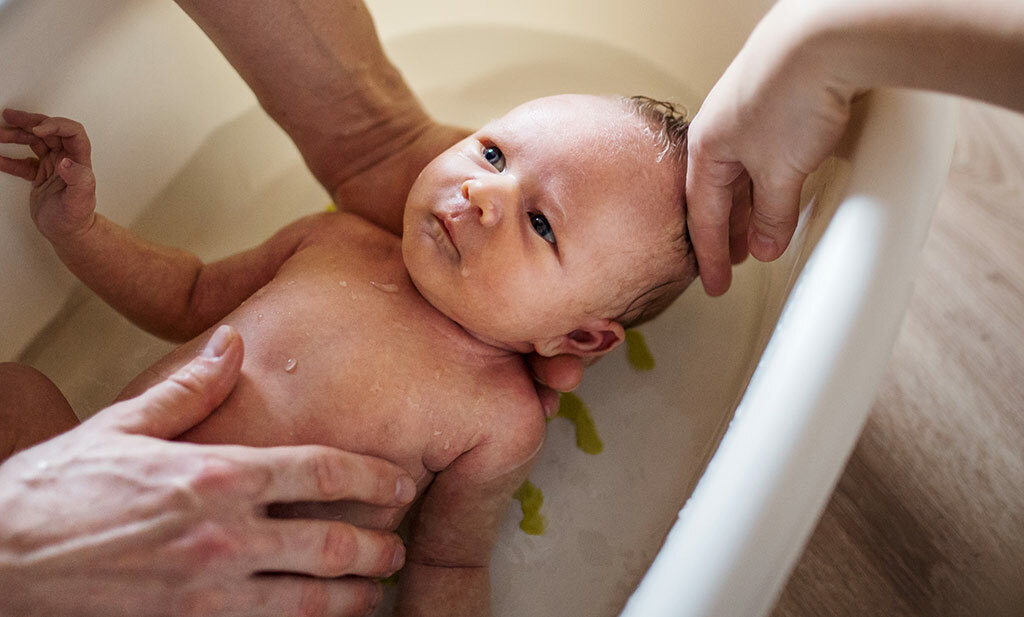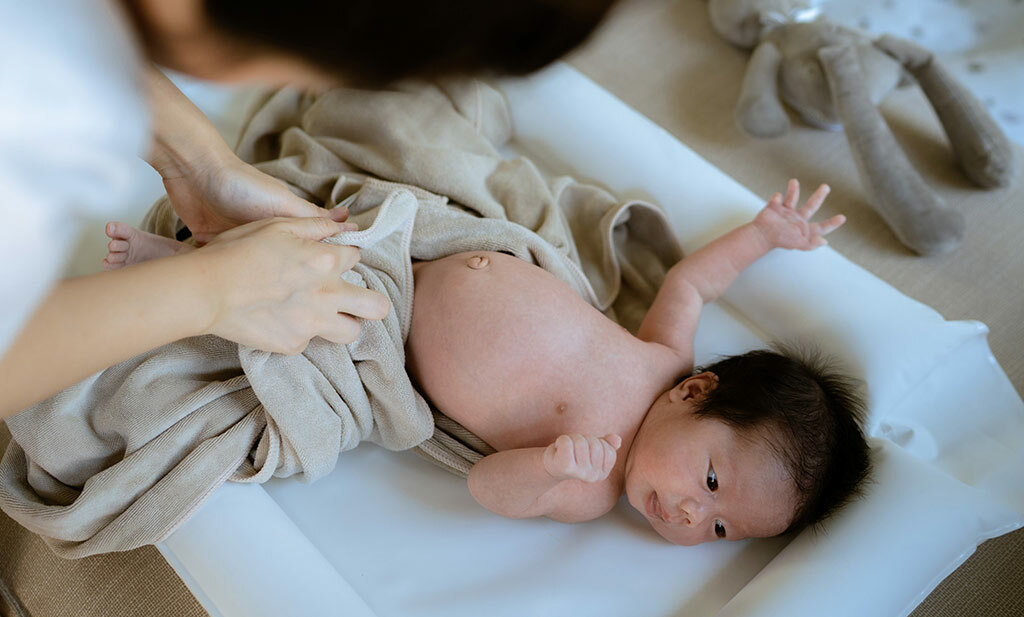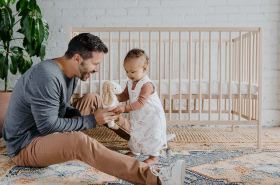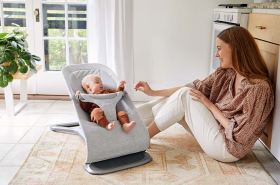
Imagine floating weightlessly, hearing gentle splashes, and feeling warm water envelop your body… lots of would enjoy such a soothing and relaxing bath. Your baby certainly does. There are only a few who don’t. Babies are in their element when in water. After all, they’ve typically spent nine months living in amniotic fluid. But does this mean you can pop your newborn into the tub straight after birth? Not quite. So when can you start bathing a baby? How often should you bath them? And for how long? What precautions should you take? These are questions our midwife and baby expert, Katrin Ritter, will answer today. Let’s ensure a worry-free bathing experience with your little ones.
When Can You Start Bathing a Baby?
After birth, your baby still has a bit of umbilical cord attached to their navel, which naturally falls off after about 10 to 14 days. If you want to be absolutely certain no germs from the bathwater enter the wound, the answer to “When should I give my baby their first bath?” is: After roughly 14 days, when the umbilical cord stump is gone and the belly button isn’t inflamed. In some cases, an earlier bath might be fine. It’s best to discuss this with your midwife.
Washing Your Newborn Without Bathing?
Since your little ones don’t really sweat yet, or their sweat doesn’t smell, a quick wipe-down on the changing table usually suffices. But it should be thorough and cover all the creases. Dirt, fluff, and milk residue tend to gather in these folds, especially around the neck. You should clean the nappy area thoroughly with a soft, damp cloth during each nappy change and dry it well. It’s handy to keep a bowl of lukewarm water by the changing table.
How Often Should You Bathe Your Baby?
Although many babies are real water babies, less is more when it comes to bathing. A baby’s skin is still very delicate, and frequent baths can dry it out. So, it’s best to let your baby have a dip in warm water only once or twice a week for five to ten minutes.
The Right Way to Bathe Your Baby
When your newborn is ready for their first bath, there’s quite a bit to consider. Timing, water temperature, the correct holding technique, and preparation before and after are all important. Let’s list the key aspects for a successful baby bath:
Options for Bathing a Baby: Using Baby Baths
A small bathtub makes it easier to hold your baby than a large one. You don’t have to bend down as much or use as much water. With a stand, it’s particularly easy on your back and pelvic floor, as you can bathe your baby while standing. When choosing where to place it, remember you’ll need to fill it with water and empty it after bathing. It’s best to set it up next to the sink and get a suitable hose for draining. A changing unit with a baby bathtub underneath that you can easily place on your bathtub (if you have one) is especially practical. Simply pull out the tub for bathing, fill with water, and drain.
Options for Bathing a Baby: Without a Baby Bath
1. Bathing with Baby in the Big Bathtub
You can bathe together with your baby in the big tub. Make sure there are always two adults, so one can hand the baby over and take them back when the other is in the tub. There’s a risk of slipping!
2. Bathing Baby in the Sink
If your sink is large enough, there’s no reason why you can’t bathe your little one in it during the first few weeks. Please thoroughly clean it beforehand and be careful with the tap (don’t add water with the baby in the basin, it could be too hot).
3. Showering Together with Baby
From about five to six months old, you can start showering with your baby, holding them in your arms. The earlier you practise showering with your little one, the sooner they’ll get used to water coming from above. Remember, things can get quite slippery – both in and out of the shower. It’s best to have someone assist you, handing the baby to you and taking them back afterwards. Place a non-slip mat on the floor for added safety. Also, consider checking your water for Legionella bacteria, as this can lead to pneumonia.

When’s the right time for bathing a baby?
There’s no one-size-fits-all answer to this question. Every baby is different, and each family has its own daily routine. Some find bathing baby fits best into their morning routine, while others prefer it as part of the bedtime ritual. A bath can be quite exciting for babies, and they often fall into a deep, long sleep afterwards. Find out what works best for you and your little one. However, avoid bathing when your baby is very hungry or has just eaten. Neither scenario is ideal for a relaxing bath time.
Baby bath temperature
The ideal water temperature is about 36-37 degrees Celsius. Always check this with a bath thermometer beforehand. If you’re experienced, you can also check with your wrist or elbow. The water should feel cool rather than hot. Always run the water before putting your baby in and never add hot or warm water afterwards. There’s a real risk of scalding! The room temperature should ideally be 23 to 24 degrees. Simply turn up the heating beforehand and/or switch on a heater/radiator near the changing table if you have one.
Bath additives for baby baths
Clear water is perfectly sufficient for washing your baby. If your baby has particularly dry skin, you can add a dash of neutral oil (olive or almond oil) or breast milk to the bathwater. When your baby starts crawling or walking, you can begin using a mild shower gel or shampoo if needed. Ensure it contains few or no additives or fragrances and has a skin-friendly pH value (5.5 to 6). The only exception: oily hair or birth residues that don’t dissolve in water. In these cases, you can use a gentle baby shampoo earlier.
Bathing a baby – the right grip
As a wet baby can be quite slippery, you should hold them securely in your arms or hands. A special bathing grip goes like this (example with baby’s head on left arm):
- Put your left arm under baby’s head and shoulder/upper back
- Grasp their arm with your index finger and thumb
- Put your right hand on baby’s bottom
- Your index finger and thumb of the right hand should grasp their thigh
How to bathe a baby properly? A guide
Those are the bathing basics. To ensure you don’t suddenly realise something isn’t where it should be mid-bath and end up running through rooms with a wet baby, here’s a step-by-step guide to bathing baby:
- Close all windows and doors, and warm the bathroom to about 23 degrees Celsius.
- Prepare the changing area with all necessary items and baby clothes. If you have one, switch on a heater near the changing table.
- Place a flannel, bath thermometer, (pre-warmed) towel, muslin cloth, and any bath additives like olive oil or breast milk within easy reach of the bath.
- Fill the baby bath with water at 36-37 degrees Celsius, about 12-15 centimetres deep. Always check the temperature!
- Dampen a soft flannel or cotton pad and set it aside for cleaning your baby’s face.
- If your baby has dry skin, you can now add a neutral oil or breast milk to the bathwater.
- Undress your baby and clean their bottom if needed. Now, hold them securely in the bathing grip.
- Gently lower your baby into the water, smiling and speaking softly. Let their feet touch the water first, moving them slowly towards the edge of the bath.
- Once their feet touch the bath’s edge, you can remove your supporting hand from their bottom and use it to wash them.
- Use the damp flannel to clean your baby’s face first. Start with the eyes (from outer to inner corner), then the rest of the face. Leave the hair for now. Don’t use bathwater for the face.
- Gently wash your baby from top to bottom with the flannel, leaving the genital area for last. Remember to clean skin folds where dirt can hide: behind the ears, in the arm and groin creases, on the neck…
- Finally, wash the hair with the flannel or muslin cloth to prevent your little one from getting cold too quickly.
- If you like, you can spread the muslin cloth over your baby to keep them warm and feeling secure. Keep wetting it with warm water. This allows your baby to relax in the bath a bit longer.
- Now, use the bathing grip as before (free hand back on baby’s bottom and thigh) and slowly lift your baby out of the bath.
- Wrap them in the pre-warmed towel and gently pat or cuddle them dry. Don’t forget the skin folds and between the toes! Only apply cream after consulting your midwife or paediatrician. Never use a hairdryer – it can cause burns or worse if your baby suddenly urinates and hits the dryer.
Say goodbye to uncertainty – our tips for bathing a baby with confidence
Who would have thought there was so much to consider when bathing a baby! But you know how it is: everything feels different and new with a tiny newborn. And for the little one, it really is all new. You simply want to do everything right. That’s exactly why we’ve gone into so much detail about bathing a baby today. Once you’ve bathed your little one a few times, you’ll notice that all the steps come naturally, and you’ll do everything instinctively. Guaranteed. If you’re nervous, do have your midwife show you at least once, and take turns bathing the baby with your partner if you have one. Enjoy!
Featured photo from Istock



